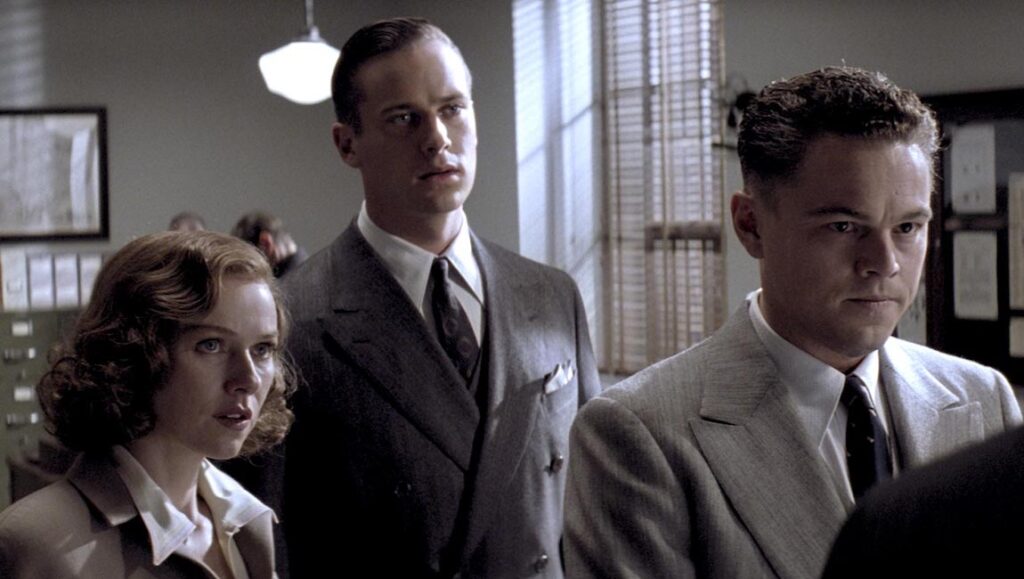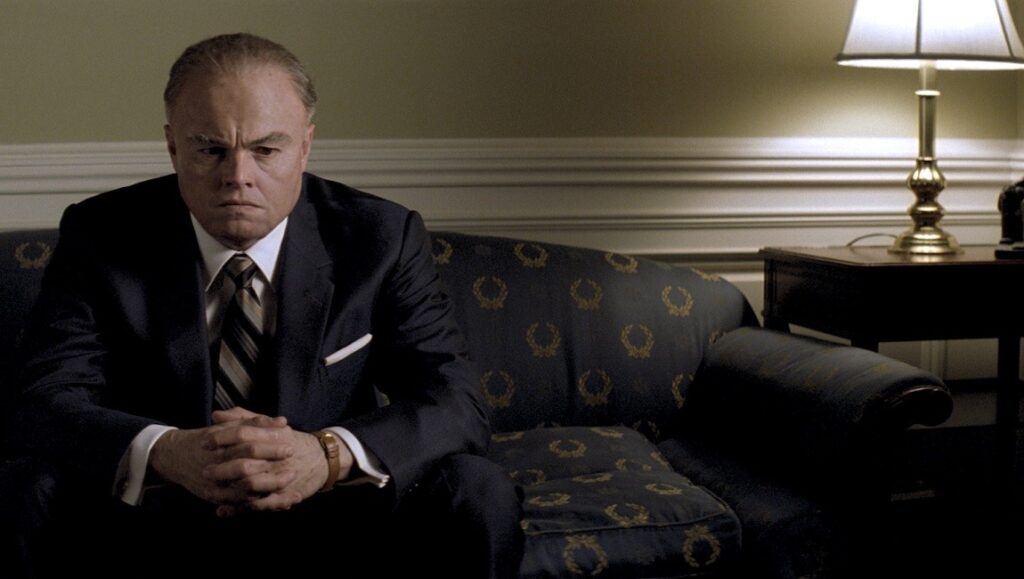Clint Eastwood likes inky color patterns, tar-black shadow cutting across battleship grey sterility, and drab, olive-green dress. The actor-director has performed a gradual shift towards this palette, eschewing the blood-red paint of High Plains Drifter, the magic-hour light of The Outlaw Josey Wales, the seaside ambience of Sudden Impact, and the dusty, picturesque landscapes of The Bridges of Madison County, which matched heightened emotional and physical stakes with serendipitous weather and all methods of contrast. Soon though, the opening WB logo came delivered in a morass of darker hues, and cinematographer Tom Stern hopped aboard the Eastwood project for a good decade and a half of steady work of patented striking, nigh-monochrome photography.
The director’s career to this point was a relatively regular oscillation between contemporary genre pieces and Westerns, though his catalog in the 21st century hews closer to that of a period piece portraitist, one who veils his consummate subversiveness in ostensibly prestige material (all matters of adaptation, significant “feel-good” historical events, etc.). Of course, looking backwards to the life and times of such varied figures of pure Americana — like J. Edgar and Frankie Valli — has coincided with enough real-world controversy and finger-pointing for Eastwood to be tagged as a conservative nostalgist, an undaunted proponent of law and order, a sympathetic gaze cast upon tyrannical jingoists and paranoid politicians.
But then there’s that color palette again. Simply put, a Clint Eastwood period piece presents a past that looks like it would have been absolutely awful to have lived through, all forms of bloodless entities swallowing up individuals, omniscient gray backdropping New Jersey clubs and LaGuardia Airport, French bullet trains and government halls. More than anything, Eastwood thrives in spaces that are merely functional: Sully’s (2016) centerpiece is a breathless, throat-grabbing recreation of 2009’s Miracle on the Hudson, but this climax is bookended with hearing committees, Times Square bars, and Marriott Hotel façades, rather deflating settings for the bona fide celebrity who’d just committed a veritable act of impossible heroism. As Tom Hanks’ eponymous pilot disappears further into his own head — where memories and traumatic what-if scenarios mingle with one another — the general anonymity of the spaces he moves through signify this contrasting inwardness, an external manifestation of withdrawal.

Some of Eastwood’s preoccupations with heroism are more nominal than others — Sully is far more sympathetic than 2009’s J. Edgar. The latter film is one of the director’s most misunderstood works (Leonardo DiCaprio and Armie Hammer in pasty old-man prosthetics is obviously too much for some) though it’s a truly monumental, dense project, one that operates within the “objective” model power study as displayed by everything from Preminger’s Advise & Consent to Robert Caro’s The Power Broker. J. Edgar marks the precise points in which idealism is conflated with paranoia, power, obsession, and, most importantly, delusion. This is erosion occurring at a glacial pace (even with the constant temporal jumps), but the subjects — DiCaprio’s J. Edgar specifically — confuse such for a capitalization upon their diminishing qualities, just like, say, Robert Moses. Eastwood establishes the misplaced motivation right from the beginning, in which an elderly Edgar embodies distrust, racism and a thirst for the public spotlight, before the first flashback outlines a series of bombings of senators and bankers; in this moment, he pledges allegiance to both, and here is where his patriotism devolves into handy buzzwords like “Bolshevik” and “radical.” The bureau director’s idea of a revolutionary uprising never materializes, and he himself is never even present in the ostensible achievements, too nervous is he to handle a gun at the sites of arrest (revealed in a damning flashback, which also implies that much of this film is self-aggrandized misremembering). Stern’s elegiac cinematography does lend the film a tragic majesty, but here is where any sort of ideological alignment ends. Hoover was a crystallized example of the vampiric public figure, and Eastwood allows for him to implicate himself over and over again. As is proven by our very first glimpse into his private quarters — delivered only upon his death at the close of the film — this was a man addicted to archaic tenets of deification and preservation.
Expectations of the period piece — or, biopic, which here still qualifies — are subverted and outright challenged by J. Edgar’s ping-ponging temporality, the general apocryphal nature of its protagonist disproven with the passage of time. This bucking of convention, however, can’t be enacted without a prior embrace: the casting of DiCaprio, and his presiding voiceover that teases a to-be-respected authority as exuded by the film’s subject. J. Edgar is perhaps one of the densest amalgamations of Eastwood’s directorial tics, where each decision seems to contradict the last, with Edgar made a figure deserving of pity as he mourns his dead mother in the sepulchral shadow of her room, and then revealed as a phony as he freezes at numerous arrest sites, which then acts as the insidious, motivating springboard to sublimate his rancor and racial prejudice in underhanded surveillance methods. The indulgence of repressed sexuality may be a relatively trite development for a film dominated by a high-ranking megalomaniac, but it’s at least creatively attuned to that aforementioned bloodlessness. The history being told is a void of healthy emotion, and its strange chromatica begs you to sink down with it.

But then how to accept a film like Jersey Boys? Yet another biopic, a smash-hit adaptation, a faux-real-time documentary, a commentary on the perils of fame? And as goes without saying, it’s laced with the music of Frankie Valli and the Four Seasons, omnipresent earworms that have come to perhaps wrongly connote the group’s work with happy occasions (and wedding playlist staples), as the film seems to posit. Jersey Boys never transcends its ashen palette, even as the group’s popularity begins to crest; in fact, it’s just as if the Jersey Boys are entering their decline within the blink of an eye, with familial and economic troubles piling up as fast as the songs are climbing the charts. It’s an errant biopic, the straight-to-camera testimonies an even more damning tool of complicity than J. Edgar’s deluded subjectivity. Near the film’s opening is a frame of compositional exposition that is remarkably concise in foreshadowing Jersey Boys’ deflated arc: in the pall of nighttime, Eastwood’s camera passes over a mantelpiece at the Valli home, which is modestly festooned with images of Frank Sinatra and the Pope. These enduring pillars of aspired artistry and morality practically set up the group to fail, the funereal assembly of this particular shot sealing the fate of the boys, this sense of dashed dreams not even dispelled by the jubilant closing musical number.
But Eastwood is ultimately less a revisionist than a pragmatic historian; the party-line on the director is that he is constantly self-assessing his own image, and while true, he does so by assessing a past that the film industry he is thoroughly entrenched in takes for granted. Even his Los Angeles, noir picture, Changeling, is beset by frequently inclement weather, more swaths of rain than there is California sun. Or take how in Richard Jewell, the Olympics are entirely an afterthought, the recurring monolithic world event falling just outside of the film’s working-class purview. Eastwood’s period pieces can be construed as rose-tinted reclamations of rocky histories, but he always goes the extra mile visually, lavishing those dark — off-putting, even — tones on films whose events are only a few years removed from the current cultural consciousness. It’s a suffocating aesthetic decision, to say the least, hard-headed in its monochromaticity, but also transcendent in how the shadows glom upon the film’s stars, as if isolating them in a black box theater. For Eastwood, the passage of time is a downward spiral flecked with inklings of heroism and all around benevolence, and he gives proper directorial attention to each.


Comments are closed.